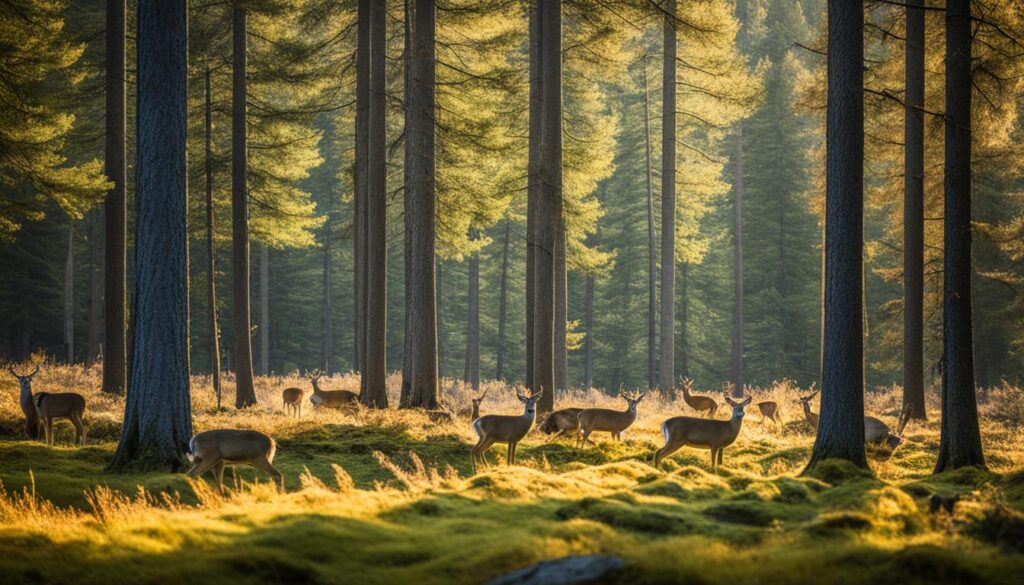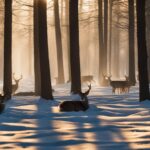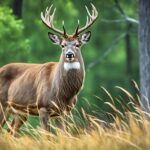Do you ever wonder how deer sleep? Understanding deer sleeping patterns is not only fascinating but also crucial for wildlife enthusiasts, hunters, and anyone who spends time in areas inhabited by these majestic creatures. While their sleep behavior may differ from ours, it is equally intriguing.
Deer sleep anywhere they bed, either singly or in groups, seeking out heavy cover during daylight hours. This preference for secure locations ensures their safety and minimizes the chances of detection by predators. If you’re lucky enough to stumble upon a sleeping deer, you might notice that they assume different sleeping positions based on the weather. During cold weather, some deer tuck their noses under their hind legs to stay warm and conserve energy.
Contrary to popular belief, deer do not enter a deep slumber like humans do. Instead, they sleep in short bouts, averaging about 30 minutes. These brief periods of rest allow them to maintain a certain level of alertness, ready to respond to any potential threats or disturbances. Between sleep cycles, deer may stand, stretch, urinate, and defecate before lying back down.
One unique aspect of deer sleep is that they keep their eyes open. This constant vigilance enables them to monitor their surroundings for any signs of danger. Sneaking up on a sleeping deer is a rare feat, as their acute senses remain on high alert even during sleep.
Content Highlights
ToggleKey Takeaways:
- Deer sleep in short bouts of around 30 minutes to maintain alertness.
- They prefer heavy cover during daylight hours for safety.
- Deer sleep with their eyes open, constantly monitoring their surroundings.
- They may assume different sleeping positions based on the weather.
- Sneaking up on a sleeping deer is a rarity due to their heightened senses.
Where Do Deer Sleep?
When it comes to finding a place to sleep, deer prioritize security and cover. They seek out locations that provide them with protection from predators and a sense of safety. Let’s explore some of the common places where deer choose to bed down.
- Heavy Brush: Deer often select areas with dense vegetation, such as thickets or heavy brush, to bed down. These areas offer excellent cover and concealment.
- Rugged Terrain: Hillsides, steep slopes, and rugged landscapes also serve as popular bedding spots for deer. These areas provide natural barriers and make it more challenging for intruders to approach undetected.
- Habitat Proximity: Deer may choose to sleep in locations that are near essential resources like feeding areas or water sources. This allows them to conserve energy by having easy access to necessary sustenance.
It’s important to note that the behavior and sleeping patterns of deer can vary depending on the season. During the peak of the rut, bucks are more active and engaged in breeding activities, which means they may be less likely to sleep or rest for extended periods.
Understanding where deer sleep is crucial for wildlife enthusiasts and hunters alike. By identifying these bedding areas, one can better observe and appreciate these magnificent creatures in their natural habitat.

Deer choose their sleeping locations with careful consideration, prioritizing their safety and well-being. By respecting their need for secure cover and understanding their sleeping habits, we can foster a deeper appreciation for these graceful animals.
Deer Sleep Cycles and Behavior
Understanding the sleep cycles and behavior of deer can provide valuable insights into their daily patterns and habits. A typical deer sleep cycle lasts about 30 minutes, with alternating periods of dozing and alertness. During the dozing phase, deer may sleep with their eyes open or closed, constantly monitoring their surroundings. They remain light sleepers and can quickly respond to any potential threats.
Interestingly, deer may change their head position multiple times within a sleeping bout, adjusting to ensure optimal vigilance. Before and after standing up from their bed, they also engage in grooming activities, maintaining their cleanliness and readiness.
Deer sleep cycles are designed to maintain their alertness while still allowing for essential rest. This behavior ensures their survival in the wild, as they are constantly exposed to potential predators.

| Sleep Phase | Description |
|---|---|
| Dozing | Deer are in a light sleep state, potentially with eyes open or closed. |
| Alertness | Deer remain vigilant and continuously monitor their surroundings. |
| Head Position | Deer may change their head position multiple times during each sleeping bout. |
| Grooming | Deer groom themselves before and after standing up from their bed. |
Insights into Deer Bedding Patterns
When it comes to understanding deer behavior, their bedding patterns play a crucial role. Both bucks and does have distinctive preferences when it comes to finding the perfect place to bed down for the day.
Bucks are known to bed with intention and prioritize their senses of smell, vision, and hearing. They often seek out locations that provide visual advantages, such as elevated terrain or areas with good visibility. Additionally, bucks prefer positions that offer a wind advantage, with the breeze at their back to help them detect any approaching danger. They also tend to choose bedding spots that provide an auditory advantage, allowing them to hear any possible threats nearby.
On the other hand, does typically bed in groups and prioritize proximity to feeding areas. They seek out locations that offer easy access to food sources, ensuring they can quickly replenish their energy when they wake up. Being part of a group also provides extra safety, as there are more sets of eyes and ears to detect potential predators.
It’s important to note that deer bedding locations can change throughout the year based on various factors. These include the availability of foliage, the level of cover, the abundance of food sources, and the amount of human pressure in the area. By carefully examining deer beds and understanding their purpose, hunters can gain valuable insights for forming effective hunting plans that take advantage of the specific bedding patterns of bucks and does.
- California Deer Hunting Guide: Seasons, Rules, Permits, and More - 26 June 2024
- Arkansas Deer Season 2024 [Schedules, Licenses, Bag Limits & More!] - 26 June 2024
- 2024 Arizona Deer Season New Dates & Rules! - 25 June 2024




